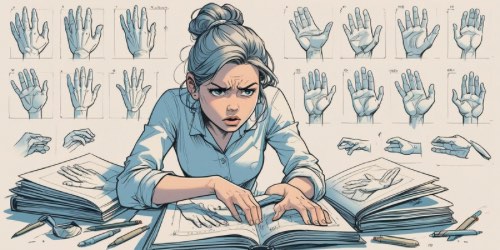Why Are Hands So Difficult to Draw?
You sit down to draw your character—everything’s flowing great… until you get to the hands. Suddenly, it feels like your pencil has forgotten how to function. If that sounds familiar, you’re not alone. Drawing hands is one of the most dreaded tasks for beginners (and even pros).
But why?
Because hands are complex. They have 27 bones, multiple joints, and an incredible range of motion. They’re like tiny machines—capable of folding, flexing, pointing, holding, and gesturing—all in unique combinations. On top of that, we see and use our hands constantly, so even the smallest mistake can feel glaringly obvious.
The Real Reason: We Know Hands Too Well
We have an almost subconscious understanding of what hands are supposed to look like. If a drawing of an ear or elbow is a little off, most people won’t notice. But a slightly wrong finger proportion? Everyone will clock it. That’s the curse—and the opportunity—of drawing hands. When you get it right, your drawing instantly levels up.
Start with Shapes, Not Fingers
Instead of jumping into drawing each finger, begin by blocking out the hand with simple shapes:
- Palm = a box or wedge
- Fingers = cylinders
- Thumb = a curved wedge at an angle
Once you break the hand down into basic forms, it becomes easier to rotate, pose, and draw it from different angles.

Use Your Own Hands as Reference
One of the best models is literally attached to you. Use your phone’s selfie timer, a mirror, or even your webcam to capture different hand positions. Try sketching:
- Open relaxed hand
- Pointing finger
- Holding an object
- Closed fist
The more you draw from life, the more natural your stylized hands will become.
Gesture First, Details Later
Don’t get lost in fingernails and knuckle wrinkles too early. Focus on the gesture—the overall motion and attitude of the hand. Is it reaching? Gripping? Signaling something? The emotion of the pose comes first. The details are just decoration.

Watch These Artists Draw Hands
Sometimes the best way to learn is to *watch someone else do it.* These tutorials break things down in ways that are easy to follow—especially if you’re stuck staring at your sketchpad wondering where to start.
1. Drawing Hands is Hard. This Tutorial Isn’t. – DrawlikeaSir
This tutorial is short, clear, and beginner-friendly. If you’ve been avoiding hands altogether, this one gives you a confident first step into structure and pose.
Even in just a few minutes, this video can shift your mindset from “this is impossible” to “I think I can actually do this.”
2. How to Draw Hands for Beginners – Art by Triston
Triston goes deeper into proportions and basic hand shapes. It’s a solid guide if you want to understand not just how to draw hands—but how they’re built.
By the end of this video, you’ll have a system to start with every time—and that consistency is what makes drawing hands less scary.
3. How to Draw Hands and Hand Poses – Marc Brunet
Ready to level up? Marc Brunet explores more advanced hand gestures and character poses. This one’s great for learning *how to add emotion and personality* to your hands.
His breakdowns will help you turn awkward-looking fingers into expressive tools for storytelling.
Practice with Purpose
Instead of drawing random hands, build your own little challenges:
- Draw 10 hands holding different objects
- Sketch 5 hands showing strong emotions (like anger or fear)
- Draw your character’s hands doing something they love
These exercises connect technical skill with storytelling—which is what great character design is all about.
Still struggling with hand poses? These resources might give you the edge:
Final Thoughts
Drawing hands is hard because they matter. They express action, emotion, and personality all at once. But with the right mindset and a bit of structure, you can absolutely improve. Don’t skip them. Don’t hide them behind pockets or conveniently placed smoke clouds. Face the hands head-on—and watch your art grow.




























